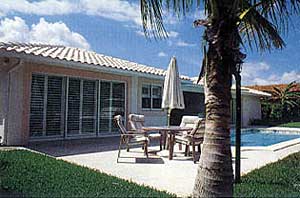How and Why Laminated Glass Solutions Meet Expanding Hurricane Code Requirements
Additional Benefits of Hurricane Impact Laminated Glass
The benefits of high impact laminated glass reach far beyond shard retention and battling flying debris. Those particularly applicable to hurricane zones relate to safety, noise reduction, intrusion resistance, greater bomb blast protection-and complying with the turtle code.
Safety from Accidental Injuries
Aside from hurricane impact requirements, glass installed in doors and large glass panels is often required to meet safety-glazing requirements designed to minimize cutting and piercing injuries resulting from accidental glass impact. Existing building code requirements are based on the federal safety-glazing standard, CPSC 16 CFR 1201, promulgated in 1977 by the Consumer Product Safety Commission. Two levels, Category I and Category II, define acceptable performance.
 |
| Sliding doors and windows of the Crawford residence were
refitted with laminated glass to provide hurricane impact
protection and reduce noise from the outside. Courtesy of: DuPont Glass Laminating Solutions |
For Category I compliance, the glazing must withstand one 150 foot-pound impact produced by impacting the glazing material with a 100-pound shot bag from a vertical height of 18 inches. For Category II compliance, the glazing must withstand one 400 foot-pound impact produced by impacting the glazing material with a 100-pound shot bag from a vertical height of four feet. Pass-fail criteria for impacted laminated glass samples require that no openings are present which will allow the passage of a 3-inch diameter steel sphere.
Given the more rigorous testing standards required for hurricane impact resistance, hurricane glass will likely comply with building code requirements for safety.
Noise Control
Laminated glass used for hurricane impact resistance has proven to be an excellent barrier to noise, having a higher sound reduction index than monolithic glass of equal thickness between the frequencies of 125Hz and 3,000Hz. Compared with monolithic glass of the same thickness, laminated safety glass made with an engineered acoustical interlayer can reduce mid-frequency noise sensation by about one half. (Noises most objectionable to humans such as jet engines, dogs barking and electrical motors fall in the mid-frequency 1,000 to 3,000 Hz range.) Sound dampening is due to the "viscoelastic" properties of the interlayer material and varies depending on glass and interlayer thickness and softness.
Ray Crawford's waterfront home in South Florida incorporates more than 100 sq m of sliding doors and windows, affording the family a spectacular view of the water. With the view, however, came excessive noises from speedboats racing along the waterways. To solve this problem, Crawford decided to refit his home with laminated glass. He noted, "I knew it would allow us to continue enjoying clear, distortion-free views while solving our immediate noise problem."
Intrusion Resistance
Laminated glass ensures a safer building because glass interlayers retain glass fragments after breakage by intruders. This past June, employees of the Day Surgery Center in Winter Haven, Florida, arrived at work and noticed a broken window near the back of the facility. The exact motive for the break-in was unclear but, as employees surveyed the damage, they were relieved to find that nothing was missing or damaged. They realized, in fact, that the burglar never even entered the facility.
According to Dr. Robert Lerner, President of Physicians of Winter Haven, LLC, "When we were selecting windows for the surgical center, we wanted to provide hurricane protection, but the recent break-in attempt demonstrates the ability of laminated glass to resist impact as well." He noted that the burglar tried to remove the glass shards to gain entry, but his tools were no match for impact resistant glass, and he eventually fled the scene.
Blast Resistance
Laminated glass can be designed to withstand bullets and bomb blasts by using multiple or thick layers of glass and interlayer. The Wilkie D. Ferguson Jr. Courthouse in Miami is the first in the country designed to withstand both bomb blasts and hurricane-force winds. The new building, which spans two city blocks, is the largest federal courthouse in the United States and meets Miami's stringent hurricane codes as well as U.S. government security standards for blast mitigation. The courthouse is part of the GSA's Design Excellence Program, which commissions designers and artists to improve the design and quality of federal buildings.
Turtle Code Compliance
While architects may appreciate the many design and energy-saving options presented by laminated glass and its low-E and tinting options, those specifying glazing systems in hurricane zones, should be aware of the "Turtle Code." These are requirements intended to maximize protection of sea turtles that nest along the Atlantic and Gulf Coast beaches from May 1 to October 31 of each year. Sixty days after eggs are laid, the newborn hatchlings emerge. When they should head out to sea, the hatchlings, following their inborn tendency to move in the brightest direction, often become confused and are attracted back to the bright lights of the shoreline. As a result a number of local building codes or ordinances require a visible light transmittance of .45 or less on all new construction windows within line sight of the beach. A typical solution is to specify laminated glass with a tinted gray interlayer that falls within the acceptable visible light transmittance and meets hurricane impact requirements in coastal areas adjacent to turtle n









